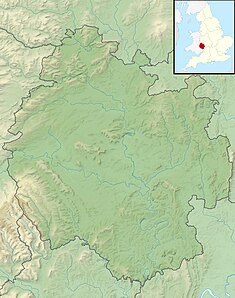Garway Dovecote
| Garway Dovecote | |
|---|---|
 | |
| Type | Dovecote |
| Location | Garway, Herefordshire |
| Coordinates | 51°53′51″N 2°47′34″W / 51.8976°N 2.7929°W |
| Built | 14th century |
| Architectural style(s) | Vernacular |
| Governing body | Privately owned |
Listed Building – Grade I | |
| Official name | Dovecot about 80 yards southeast of the Church of St Michael |
| Designated | 1 March 1960 |
| Reference no. | 1348781 |
| Official name | Garway Dovecote |
| Reference no. | 1001765 |
Garway Dovecote stands close to the Church of St Michael in the village of Garway, Herefordshire, England. Historic England dates the dovecote to the early 14th century. The original structure was built by the Knights Templar, and later reconstructed by their successors, the Knights Hospitaller. The dovecote is a Grade I listed building and a scheduled monument.
History and description
[edit]The present dovecote dates from the 14th century when it was built by the Knights Hospitaller. Documentary and build evidence suggests that this was a reconstruction of an earlier building erected by the Knights Templar. The Templars had established a preceptory at Garway in the 12th century.[a][3] The Church of St Michael, which stands adjacent to the dovecote, was originally the principal building of the preceptory site.[4] The Friends of Garway Church society gives a build date for the dovecote of 1326.[b][5] The dovecote is circular and constructed of sandstone rubble with a flattened conical roof. The interior holds 19 rows of nesting boxes.[c][6] The pigeons kept within the structure provided a source of meat, and their droppings were used as fertilizer.[7] In his study, A Book of Dovecotes published in 1920, Arthur Owens Cooke described the Garway dovecote at unusual length owing to its "its undoubted age [and] the excellence of its workmanship".[8] The Friends' website describes Garway as "the finest medieval dovecote in England",[1] a view supported by Alfred Watkins in his study, Pigeon Houses of Herefordshire and Gower.[9] It is a Grade I listed building and a scheduled monument.[6][10]
Gallery
[edit]-
Illustration from the Archaeological Journal, 1845
-
Roof
Notes
[edit]- ^ Following the suppression of the Order in 1307, the Templars' lands, including the Garway estate, were given to their rivals, the Knights Hospitaller.[2]
- ^ The Friends of Garway Church society indicate that an inscription above the doorway gave the date of 1326, and was deciphered in the 19th century by the Reverend John Webb.[5] Historic England's listing record notes that the inscription is now illegible.[6]
- ^ The Friends suggests that there are 20 rows of nesting boxes.[5]
References
[edit]- ^ a b "Garway Church". Friends of Garway Church. Retrieved 11 August 2024.
- ^ "Herefordshire Through Time". Herefordshire Council. 2 March 2015. Retrieved 11 August 2024.
- ^ "Dovecot, Church of St Michael, Garway, Herefordshire". Historic England. Retrieved 11 August 2024.
- ^ Historic England. "Church of St Michael (Grade I) (1099751)". National Heritage List for England. Retrieved 11 August 2024.
- ^ a b c "Dovecote, Church Farm". Friends of Garway Church. Retrieved 11 August 2024.
- ^ a b c Historic England. "Dovecot about 80 yards southeast of the Church of St Michael (Grade I) (1348781)". National Heritage List for England. Retrieved 11 August 2024.
- ^ "Dovecotes Trail". Malvern Trails. 2 May 2015. Retrieved 11 August 2024.
- ^ Cooke 1920, p. 51.
- ^ Watkins 1891, p. 30.
- ^ Historic England. "Garway Dovecote (Grade SM) (1001765)". National Heritage List for England. Retrieved 11 August 2024.
Sources
[edit]- Brooks, Alan; Pevsner, Nikolaus (2012). Herefordshire. The Buildings of England. New Haven, US and London: Yale University Press. ISBN 978-0-300-12575-7. OCLC 759174126.
- Cooke, Arthur Owens (1920). A Book of Dovecotes. London: T. N. Foulis. OCLC 1965568.
- Watkins, Alfred (1891). "Pigeon Houses in Herefordshire and Gower". Archaeological Journal. 48. London: Longman.




